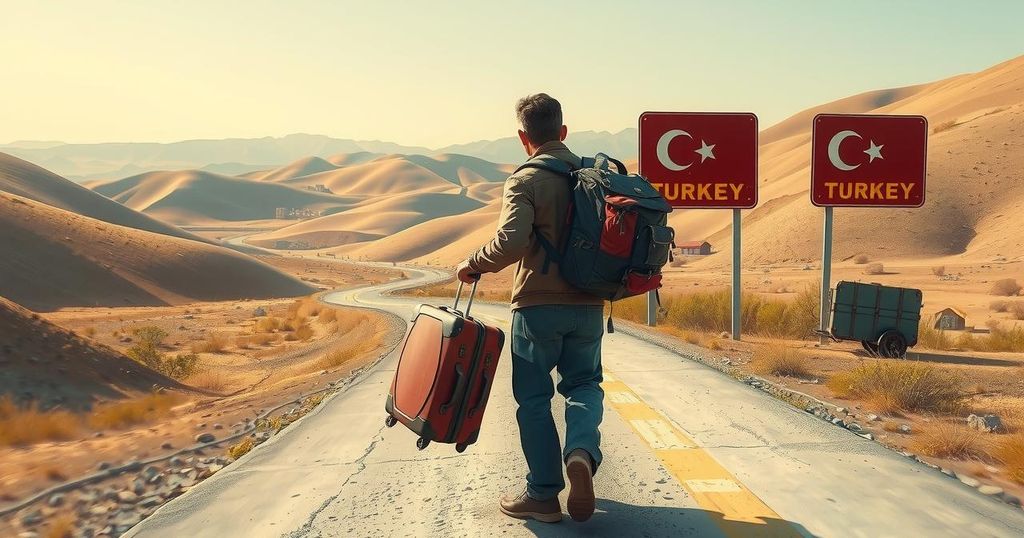From Tehran to Toronto via Turkey: An Iranian’s Bid to Flee War

Homa, an Iranian stuck in Tehran amid conflict, flees to Turkey. After four days of turmoil, she reaches the Kapikoy border. As casualties rise from the Israeli-Iranian war, travelers express both urgency and calm with some iranians choosing to remain in Tehran. The ongoing situation reflects a complex human response to the violence.
Amidst the escalating conflict between Iran and Israel, Homa, a 40-year-old Iranian business analyst now in Canada, found herself desperate to flee the turmoil back home. She had been on holiday in Tehran when the war ignited, leading to Iran closing its airspace after a significant bombing campaign from Israel. Stranded, she decided to seek alternative escape routes, attempting the lengthy bus journey of approximately 850 kilometers to Turkey’s border.
After enduring several days of chaos, Homa eventually made her way through the Kapikoy border crossing into Turkey. The crowd at the border seemed manageable, as she commented on the heavy traffic her family faced while trying to escape Tehran as well. “They’re not safe, I am worried about them,” she expressed directly, noting the concern for her loved ones left behind.
The situation in Iran worsens as official reports indicate that at least 224 people have been killed due to Israeli attacks targeting the nation’s military infrastructure. Conversely, Israel reports 24 fatalities from Iran’s retaliatory strikes. Homa still faces a lengthy journey ahead, comprising a trek through Erzurum, Istanbul, Dubai, and ultimately back to her home in Toronto.
“My journey is far from over,” she remarked, preparing for the next five-hour leg of her travels. The psychological toll has also been immense. “I couldn’t sleep for five nights in a row” she recounted, reflecting on the horrors of surviving nightly bombardment, which forced her to relocate within the city.
Communication amidst the conflict has been challenging. Homa described the unreliable internet and the struggle to access social media platforms, which have all faced severe filtration. As she navigated through the Kapikoy border, a vital crossing point between Iran and Turkey, Homa noted the flow of people was steady but not overwhelming since the situation escalated.
While movements were observed, Turkish customs officials assured that the crossing numbers had not significantly increased compared to previous years. Local tourism remained steady, with many Iranians continuing to travel within Turkey. Yet, there was an observable surge in bus bookings between Turkish cities, as many sought to escape the conflict. A bus driver remarked the demand had spiked significantly, increasing the number of buses operating during nighttime hours.
Conversely, not all Iranians at the border express a desire to flee. Ramin Rad, a 37-year-old man caught in Van for work, reflected confidence in his country’s government and the outcome of the conflict, stating: “My family is safe. How dare you change Allah’s regime?” Other travelers echoed similar sentiments downplaying the fear of exiting Tehran.
Mirzanezhad Valehzagherd, also at the border, shared that for him, the situation back home in Tehran was relatively stable. He claimed the focus of the bombardments were military sites, reiterating, “People are not fleeing Tehran”. Another traveler, a financial professional named Seher, traveling back from Tehran to her residence in Northern Cyprus, voiced her comfort about the situation back home, saying, “It’s safe over there. There’s no problem.”
Despite contrasting experiences of fleeing and staying put, the ongoing conflict continues to disrupt lives and tear families apart, emphasizing the war’s far-reaching ramifications across borders and communities who are caught in the fray.
The plight of Homa highlights the tremendous human cost of the Iran-Israel conflict and the lengths individuals are willing to go to ensure their safety. As some Iranians seek refuge from the chaos, others remain steadfast in their resolve, illustrating a divided sense of urgency amid the turmoil. The fluctuating patterns of migration and travel show that while fear exists, many are still hopeful of stability back home. This ongoing crisis calls for continued attention to humanitarian and geopolitical impacts.
Original Source: www.yahoo.com






